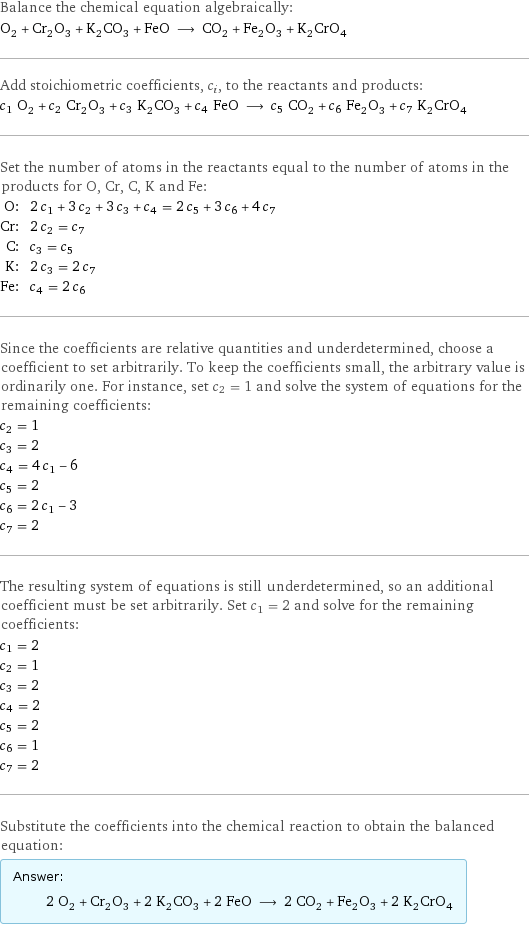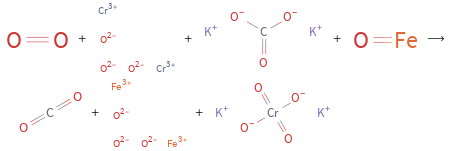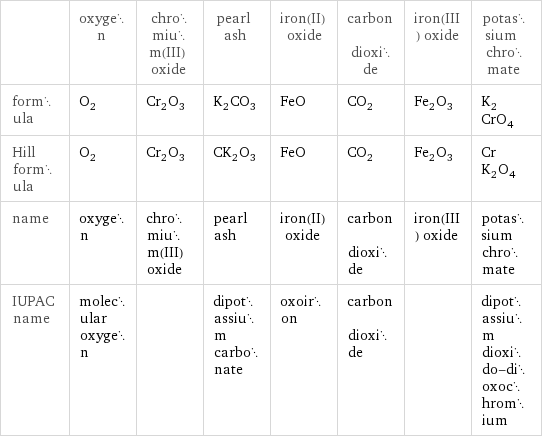Input interpretation

O_2 oxygen + Cr_2O_3 chromium(III) oxide + K_2CO_3 pearl ash + FeO iron(II) oxide ⟶ CO_2 carbon dioxide + Fe_2O_3 iron(III) oxide + K_2CrO_4 potassium chromate
Balanced equation

Balance the chemical equation algebraically: O_2 + Cr_2O_3 + K_2CO_3 + FeO ⟶ CO_2 + Fe_2O_3 + K_2CrO_4 Add stoichiometric coefficients, c_i, to the reactants and products: c_1 O_2 + c_2 Cr_2O_3 + c_3 K_2CO_3 + c_4 FeO ⟶ c_5 CO_2 + c_6 Fe_2O_3 + c_7 K_2CrO_4 Set the number of atoms in the reactants equal to the number of atoms in the products for O, Cr, C, K and Fe: O: | 2 c_1 + 3 c_2 + 3 c_3 + c_4 = 2 c_5 + 3 c_6 + 4 c_7 Cr: | 2 c_2 = c_7 C: | c_3 = c_5 K: | 2 c_3 = 2 c_7 Fe: | c_4 = 2 c_6 Since the coefficients are relative quantities and underdetermined, choose a coefficient to set arbitrarily. To keep the coefficients small, the arbitrary value is ordinarily one. For instance, set c_2 = 1 and solve the system of equations for the remaining coefficients: c_2 = 1 c_3 = 2 c_4 = 4 c_1 - 6 c_5 = 2 c_6 = 2 c_1 - 3 c_7 = 2 The resulting system of equations is still underdetermined, so an additional coefficient must be set arbitrarily. Set c_1 = 2 and solve for the remaining coefficients: c_1 = 2 c_2 = 1 c_3 = 2 c_4 = 2 c_5 = 2 c_6 = 1 c_7 = 2 Substitute the coefficients into the chemical reaction to obtain the balanced equation: Answer: | | 2 O_2 + Cr_2O_3 + 2 K_2CO_3 + 2 FeO ⟶ 2 CO_2 + Fe_2O_3 + 2 K_2CrO_4
Structures

+ + + ⟶ + +
Names

oxygen + chromium(III) oxide + pearl ash + iron(II) oxide ⟶ carbon dioxide + iron(III) oxide + potassium chromate
Equilibrium constant
![Construct the equilibrium constant, K, expression for: O_2 + Cr_2O_3 + K_2CO_3 + FeO ⟶ CO_2 + Fe_2O_3 + K_2CrO_4 Plan: • Balance the chemical equation. • Determine the stoichiometric numbers. • Assemble the activity expression for each chemical species. • Use the activity expressions to build the equilibrium constant expression. Write the balanced chemical equation: 2 O_2 + Cr_2O_3 + 2 K_2CO_3 + 2 FeO ⟶ 2 CO_2 + Fe_2O_3 + 2 K_2CrO_4 Assign stoichiometric numbers, ν_i, using the stoichiometric coefficients, c_i, from the balanced chemical equation in the following manner: ν_i = -c_i for reactants and ν_i = c_i for products: chemical species | c_i | ν_i O_2 | 2 | -2 Cr_2O_3 | 1 | -1 K_2CO_3 | 2 | -2 FeO | 2 | -2 CO_2 | 2 | 2 Fe_2O_3 | 1 | 1 K_2CrO_4 | 2 | 2 Assemble the activity expressions accounting for the state of matter and ν_i: chemical species | c_i | ν_i | activity expression O_2 | 2 | -2 | ([O2])^(-2) Cr_2O_3 | 1 | -1 | ([Cr2O3])^(-1) K_2CO_3 | 2 | -2 | ([K2CO3])^(-2) FeO | 2 | -2 | ([FeO])^(-2) CO_2 | 2 | 2 | ([CO2])^2 Fe_2O_3 | 1 | 1 | [Fe2O3] K_2CrO_4 | 2 | 2 | ([K2CrO4])^2 The equilibrium constant symbol in the concentration basis is: K_c Mulitply the activity expressions to arrive at the K_c expression: Answer: | | K_c = ([O2])^(-2) ([Cr2O3])^(-1) ([K2CO3])^(-2) ([FeO])^(-2) ([CO2])^2 [Fe2O3] ([K2CrO4])^2 = (([CO2])^2 [Fe2O3] ([K2CrO4])^2)/(([O2])^2 [Cr2O3] ([K2CO3])^2 ([FeO])^2)](../image_source/e69b395515bffe518eb76f7ed40baf2b.png)
Construct the equilibrium constant, K, expression for: O_2 + Cr_2O_3 + K_2CO_3 + FeO ⟶ CO_2 + Fe_2O_3 + K_2CrO_4 Plan: • Balance the chemical equation. • Determine the stoichiometric numbers. • Assemble the activity expression for each chemical species. • Use the activity expressions to build the equilibrium constant expression. Write the balanced chemical equation: 2 O_2 + Cr_2O_3 + 2 K_2CO_3 + 2 FeO ⟶ 2 CO_2 + Fe_2O_3 + 2 K_2CrO_4 Assign stoichiometric numbers, ν_i, using the stoichiometric coefficients, c_i, from the balanced chemical equation in the following manner: ν_i = -c_i for reactants and ν_i = c_i for products: chemical species | c_i | ν_i O_2 | 2 | -2 Cr_2O_3 | 1 | -1 K_2CO_3 | 2 | -2 FeO | 2 | -2 CO_2 | 2 | 2 Fe_2O_3 | 1 | 1 K_2CrO_4 | 2 | 2 Assemble the activity expressions accounting for the state of matter and ν_i: chemical species | c_i | ν_i | activity expression O_2 | 2 | -2 | ([O2])^(-2) Cr_2O_3 | 1 | -1 | ([Cr2O3])^(-1) K_2CO_3 | 2 | -2 | ([K2CO3])^(-2) FeO | 2 | -2 | ([FeO])^(-2) CO_2 | 2 | 2 | ([CO2])^2 Fe_2O_3 | 1 | 1 | [Fe2O3] K_2CrO_4 | 2 | 2 | ([K2CrO4])^2 The equilibrium constant symbol in the concentration basis is: K_c Mulitply the activity expressions to arrive at the K_c expression: Answer: | | K_c = ([O2])^(-2) ([Cr2O3])^(-1) ([K2CO3])^(-2) ([FeO])^(-2) ([CO2])^2 [Fe2O3] ([K2CrO4])^2 = (([CO2])^2 [Fe2O3] ([K2CrO4])^2)/(([O2])^2 [Cr2O3] ([K2CO3])^2 ([FeO])^2)
Rate of reaction
![Construct the rate of reaction expression for: O_2 + Cr_2O_3 + K_2CO_3 + FeO ⟶ CO_2 + Fe_2O_3 + K_2CrO_4 Plan: • Balance the chemical equation. • Determine the stoichiometric numbers. • Assemble the rate term for each chemical species. • Write the rate of reaction expression. Write the balanced chemical equation: 2 O_2 + Cr_2O_3 + 2 K_2CO_3 + 2 FeO ⟶ 2 CO_2 + Fe_2O_3 + 2 K_2CrO_4 Assign stoichiometric numbers, ν_i, using the stoichiometric coefficients, c_i, from the balanced chemical equation in the following manner: ν_i = -c_i for reactants and ν_i = c_i for products: chemical species | c_i | ν_i O_2 | 2 | -2 Cr_2O_3 | 1 | -1 K_2CO_3 | 2 | -2 FeO | 2 | -2 CO_2 | 2 | 2 Fe_2O_3 | 1 | 1 K_2CrO_4 | 2 | 2 The rate term for each chemical species, B_i, is 1/ν_i(Δ[B_i])/(Δt) where [B_i] is the amount concentration and t is time: chemical species | c_i | ν_i | rate term O_2 | 2 | -2 | -1/2 (Δ[O2])/(Δt) Cr_2O_3 | 1 | -1 | -(Δ[Cr2O3])/(Δt) K_2CO_3 | 2 | -2 | -1/2 (Δ[K2CO3])/(Δt) FeO | 2 | -2 | -1/2 (Δ[FeO])/(Δt) CO_2 | 2 | 2 | 1/2 (Δ[CO2])/(Δt) Fe_2O_3 | 1 | 1 | (Δ[Fe2O3])/(Δt) K_2CrO_4 | 2 | 2 | 1/2 (Δ[K2CrO4])/(Δt) (for infinitesimal rate of change, replace Δ with d) Set the rate terms equal to each other to arrive at the rate expression: Answer: | | rate = -1/2 (Δ[O2])/(Δt) = -(Δ[Cr2O3])/(Δt) = -1/2 (Δ[K2CO3])/(Δt) = -1/2 (Δ[FeO])/(Δt) = 1/2 (Δ[CO2])/(Δt) = (Δ[Fe2O3])/(Δt) = 1/2 (Δ[K2CrO4])/(Δt) (assuming constant volume and no accumulation of intermediates or side products)](../image_source/07ae2742f867ea6f0a457d85477f4c8a.png)
Construct the rate of reaction expression for: O_2 + Cr_2O_3 + K_2CO_3 + FeO ⟶ CO_2 + Fe_2O_3 + K_2CrO_4 Plan: • Balance the chemical equation. • Determine the stoichiometric numbers. • Assemble the rate term for each chemical species. • Write the rate of reaction expression. Write the balanced chemical equation: 2 O_2 + Cr_2O_3 + 2 K_2CO_3 + 2 FeO ⟶ 2 CO_2 + Fe_2O_3 + 2 K_2CrO_4 Assign stoichiometric numbers, ν_i, using the stoichiometric coefficients, c_i, from the balanced chemical equation in the following manner: ν_i = -c_i for reactants and ν_i = c_i for products: chemical species | c_i | ν_i O_2 | 2 | -2 Cr_2O_3 | 1 | -1 K_2CO_3 | 2 | -2 FeO | 2 | -2 CO_2 | 2 | 2 Fe_2O_3 | 1 | 1 K_2CrO_4 | 2 | 2 The rate term for each chemical species, B_i, is 1/ν_i(Δ[B_i])/(Δt) where [B_i] is the amount concentration and t is time: chemical species | c_i | ν_i | rate term O_2 | 2 | -2 | -1/2 (Δ[O2])/(Δt) Cr_2O_3 | 1 | -1 | -(Δ[Cr2O3])/(Δt) K_2CO_3 | 2 | -2 | -1/2 (Δ[K2CO3])/(Δt) FeO | 2 | -2 | -1/2 (Δ[FeO])/(Δt) CO_2 | 2 | 2 | 1/2 (Δ[CO2])/(Δt) Fe_2O_3 | 1 | 1 | (Δ[Fe2O3])/(Δt) K_2CrO_4 | 2 | 2 | 1/2 (Δ[K2CrO4])/(Δt) (for infinitesimal rate of change, replace Δ with d) Set the rate terms equal to each other to arrive at the rate expression: Answer: | | rate = -1/2 (Δ[O2])/(Δt) = -(Δ[Cr2O3])/(Δt) = -1/2 (Δ[K2CO3])/(Δt) = -1/2 (Δ[FeO])/(Δt) = 1/2 (Δ[CO2])/(Δt) = (Δ[Fe2O3])/(Δt) = 1/2 (Δ[K2CrO4])/(Δt) (assuming constant volume and no accumulation of intermediates or side products)
Chemical names and formulas

| oxygen | chromium(III) oxide | pearl ash | iron(II) oxide | carbon dioxide | iron(III) oxide | potassium chromate formula | O_2 | Cr_2O_3 | K_2CO_3 | FeO | CO_2 | Fe_2O_3 | K_2CrO_4 Hill formula | O_2 | Cr_2O_3 | CK_2O_3 | FeO | CO_2 | Fe_2O_3 | CrK_2O_4 name | oxygen | chromium(III) oxide | pearl ash | iron(II) oxide | carbon dioxide | iron(III) oxide | potassium chromate IUPAC name | molecular oxygen | | dipotassium carbonate | oxoiron | carbon dioxide | | dipotassium dioxido-dioxochromium